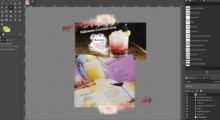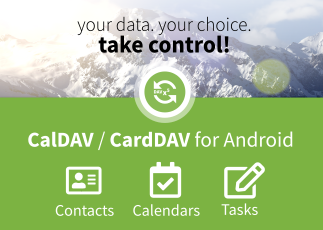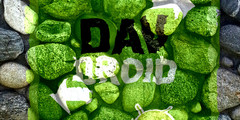task list
This discussion is connected to the gimp-developer-list.gnome.org mailing list which is provided by the GIMP developers and not related to gimpusers.com.
This is a read-only list on gimpusers.com so this discussion thread is read-only, too.
| tasks list | Alexandre Prokoudine | 24 Jan 09:48 |
| tasks list | Sven Neumann | 25 Jan 09:40 |
| task list | Sven Neumann | 25 Jan 09:01 |
| task list | Alexandre Prokoudine | 25 Jan 12:22 |
| task list | David Gowers | 25 Jan 14:20 |
| task list | Robert Krawitz | 25 Jan 14:31 |
| task list | Alexandre Prokoudine | 25 Jan 14:39 |
| task list | David Gowers | 25 Jan 14:54 |
| task list | Alexandre Prokoudine | 25 Jan 15:23 |
| task list | David Gowers | 25 Jan 22:24 |
| task list | Liam R E Quin | 25 Jan 16:45 |
| task list | Sven Neumann | 27 Jan 10:47 |
| task list | Sven Neumann | 25 Jan 19:45 |
| tasks list | Sven Neumann | 25 Jan 20:06 |
| tasks list | Alexandre Prokoudine | 25 Jan 20:45 |
| tasks list | Sven Neumann | 25 Jan 21:45 |
tasks list
On 24 January, 2008, Sven wrote
I don't think we want to publish something and call it a roadmap. But we had the plan to make a list of important tasks that outline where GIMP is heading and what we consider important to work on. Since there doesn't seem to be enough interest among the developers and other people reading this list, we still don't have such a list.
May I ask why you are asking this? And then, why you are using this thread instead of creating a new one for such a question?
Both valid questions. Thus a new thread :-)
Well, there _had been_ a beta version of the list (to which several people including myself contributed) and since then nothing has happened, so I was wondering if you still liked that idea ;-) Would it still makes sense grabbing latest version, reviewing it and hanging out to dry somewhere for people to come up and have a look?
Alexandre
task list
Hi,
On Thu, 2008-01-24 at 18:06 +0000, William Skaggs wrote:
* Construct an optional MDI version of the gui.
That is definitely not a goal. We are not willing nor able to maintain optional user interfaces. The UI has to evolve and it will be highly customizable, but we are not going to offer an optional WiW user interface.
* Allow libgimp or something like it to be linked with the core, and implement actions and tool operations by means of it, so that it will be possible to record and play macros.
We haven't talked about this and it sounds like a terrible description. Being able to record and play macros has nothing to do with linking anything with the core. Actually, I don't think that we need to put action recording on our list as that will become obsolete with non-destructive editing. And that's the actual goal.
* Make it so that sequences of transformations on a layer do not cause a steady buildup of error. (Yes, this is possible, because any sequence of affine transformations can be reduced to a single affine transformation.)
That is part of the GEGL transition and doesn't need to be mentioned explicitly.
Sven
tasks list
Hi,
On Thu, 2008-01-24 at 11:48 +0300, Alexandre Prokoudine wrote:
Well, there _had been_ a beta version of the list (to which several people including myself contributed) and since then nothing has happened, so I was wondering if you still liked that idea ;-)
I did not like any of the beta versions as they were all way too
specific and didn't really bring along a vision. And there wasn't any
feedback from other developers. My impression is that no developer
really wants this list. So I consider this attempt failed.
Perhaps if we could first decide what the purpose of the roadmap/task
list should be. I tried to raise that question when we started with this
topic. But no one ever attempted to answer it. So before we start this
again, can we have this discussion, please. That would probably help to
get us somewhere.
Sven
task list
On Jan 25, 2008 11:01 AM, Sven Neumann wrote:
Actually, I don't think that we need to put action recording on our list as that will become obsolete with non-destructive editing.
This is apples and oranges, Sven :-) Non-destructive editing boosts productivity as well, but has nothing (or very few things) in common with *automation*. All the users who ever bugged you asking for macros recording did it because they don't feel like programmers to learn Script/Python/Perl-Fu.
Alexandre
task list
Hi Alexandre,
On Jan 25, 2008 9:52 PM, Alexandre Prokoudine wrote:
On Jan 25, 2008 11:01 AM, Sven Neumann wrote:
Actually, I don't think that we need to put action recording on our list as that will become obsolete with non-destructive editing.
This is apples and oranges, Sven :-) Non-destructive editing boosts productivity as well, but has nothing (or very few things) in common with *automation*.
It does, though. If you make a chunk of graph -- say you want to gaussian-blur a layer, gradient-map some part of it, and posterize the result to 32 levels; you could do this with the following snippet of graph:
(graph root)
|
posterize (levels = 32)
|
+- atop
| |
| mask
| |
| gradient-map (gradient = )
| |
+-gauss-blur (hblur = 5, vblur = 5)
|
+-sourcelayer
In case that isn't clear:
Source layer is gauss blurred, A gradient-mapped version is made,
which is then masked.
This image is then rendered atop the gaussian-blurred image, and the
result is posterized.
This is what is conventionally covered by macros, this kind of thing.
All the users who ever bugged you asking for macros recording did it because they don't feel like programmers to learn Script/Python/Perl-Fu.
With non-destructive editing, used as above, almost all the things that users want to do are things that can be expressed in terms of a modification of the image graph. The example you see above -- the only user input required would be to choose which layer becomes sourcelayer. twould probably be pretty easy to build a 'quick change' dialog where the user can change all the involved values (eg gauss blur radius.)
The things which do not fall into that category.. * batch processing (trivial amount of programming. Just keep resetting the filenames at the leaf and root of a graph). * view handling (I'd like to be able to, say, tag an image or directory as 'pixel art', and when I opened one of those images, have an additional, 300% view appear (for real size preview). Personally I think views are one of the things that may end up needing a PDB interface*, despite the vast obsoletion that should otherwise happen (gauss blur, gradient map, colorize, what ever filter you name -- won't need a PDB interface any more, they just implement their gegl Ops)
I've just gone through the menus.. and the vast majority of actions available are directly equivalent to inserting, deleting, or shuffling nodes in a graph. The remainder alter either the context (Tools menu, View menu) or the GUI (Dialogs menu, View menu). (We might want to consider implementing a 'meta-load' Op, that would load a graph from file and pass image data through it. That would be a pretty simple and flexible way of facilitating macros shared between images -- just connect the output at a place of the user's choosing.)
What significant sequence of actions that you can take is there, that cannot be done by simple graph editing?
task list
Date: Fri, 25 Jan 2008 23:50:56 +1030 From: "David Gowers"
On Jan 25, 2008 9:52 PM, Alexandre Prokoudine
> All the users who ever bugged you asking for macros > recording did it because they don't feel like programmers to learn > Script/Python/Perl-Fu.
With non-destructive editing, used as above, almost all the things that users want to do are things that can be expressed in terms of a modification of the image graph. The example you see above -- the only user input required would be to choose which layer becomes sourcelayer. twould probably be pretty easy to build a 'quick change' dialog where the user can change all the involved values (eg gauss blur radius.)
The question is, do users what to have to learn about image graphs, or do they just want to say "save what I did so I can do the same thing to another set of images"?
task list
On Jan 25, 2008 4:20 PM, David Gowers wrote:
What significant sequence of actions that you can take is there, that cannot be done by simple graph editing?
Users do not think in terms of graphs, they think in terms of actions and sequences of actions. They want to click Record, mess around with filters etc., then just click Stop and be able to replay it to any number of other images, send this sequence of actions to a collegue or use his sequence of actions. This is about productivity.
Don't get me wrong - I'm very much excited about GEGL features ( I even did a happy dance when I saw nodes caching code committed to SVN a while ago :)), but your example is rather a demonstration of adjustment layers and/or live filters and doesn't not deal with the issue we are speaking about.
Alexandre
task list
On Jan 26, 2008 12:09 AM, Alexandre Prokoudine wrote:
On Jan 25, 2008 4:20 PM, David Gowers wrote:
What significant sequence of actions that you can take is there, that cannot be done by simple graph editing?
Users do not think in terms of graphs, they think in terms of actions and sequences of actions. They want to click Record, mess around with filters etc., then just click Stop and be able to replay it to any number of other images, send this sequence of actions to a collegue or use his sequence of actions. This is about productivity.
What I was talking about -- recording is automatic, it's always happening. Every change to the image can be recorded, because most changes (say, gaussian blurring) can be recorded with a trivial amount of memory (what type of node is it, where is it connected, what properties does it have and what are their values). This is easily seen when you look at GEGL's current XML format.
In short -- what you call 'action recording', I call 'packaging up a
chunk of the undo stack'. Really, your 'start' and 'stop' actions
would be trivial to implement:
mark the start location in undo stack; mark the end; and prompt the
user for a filename. Applying them is similarly trivial (choose an
action, load it, append to the undo stack)
task list
On Jan 25, 2008 4:54 PM, David Gowers wrote:
In short -- what you call 'action recording', I call 'packaging up a chunk of the undo stack'. Really, your 'start' and 'stop' actions would be trivial to implement:
mark the start location in undo stack; mark the end; and prompt the user for a filename. Applying them is similarly trivial (choose an action, load it, append to the undo stack)
That makes sense :) But then GEGL needs ops for handling selection, masks, paths, text... - everything that is now accessible via PDB and more. I'm not that technically experienced to say if those procedures are all exposable as ops.
Alexandre
task list
On Fri, 2008-01-25 at 23:50 +1030, David Gowers wrote: [...]
What significant sequence of actions that you can take is there, that cannot be done by simple graph editing?
You might want to look at the "nip2" graphics editor, which works this way. I find nip2 hard to use despite (or maybe because of?) the graphical interface, though.
Liam
task list
Hi,
On Fri, 2008-01-25 at 14:22 +0300, Alexandre Prokoudine wrote:
Actually, I don't think that we need to put action recording on our list as that will become obsolete with non-destructive editing.
This is apples and oranges, Sven :-)
Well, it is not the same thing, that is right. But non-destructive editing will completely change how action recording works. It would be a waste of time to do the changes needed for classic action recording (which would be a major change) and at the same time migrate to non-destructive editing. We should rather focus on the latter.
Sven
tasks list
Hi,
On Fri, 2008-01-25 at 16:54 +0000, William Skaggs wrote:
A roadmap should be thought of as a component of a full development strategy. In my view, each release cycle should have a set of target dates, and a set of essential accomplishments.
Well, we have that for 2.6. We didn't put publish it. But we discussed these points and agreed on a roadmap for 2.6. The question is, do we gain anything if we published such a roadmap officially? I am afraid that the only result would be that people will expect us to stick to the release date no matter how far the essential features are developed. And at the same time they will expect us to implement all the essential features.
The main value of a roadmap, in this context, is in planning for future release cycles. Thus, the roadmapping that should be going on now is for 2.8 and beyond, not for 2.6.
Agreed. The 2.6 development cycle is soon coming to an end and we should start to talk about what can still be achieved and what should happen next. The question is still, do we really want to make a roadmap public?
I think it would be a lot more useful if we would just collect a list of tasks that we consider important, without sticking them into a particular release time-frame. That will make it easier for new developers to participate. And that's what's most important.
Sven
tasks list
On Jan 25, 2008 10:06 PM, Sven Neumann wrote:
I think it would be a lot more useful if we would just collect a list of tasks that we consider important, without sticking them into a particular release time-frame.
This is what Inkscape guys do. They have a roadmap based on a rough estimation, what features might be released in what version, and they manage to work within it, implementing some planned features sooner than "planned" and some - later.
Their users just got used to having a new release every ~6 months, so they don't bother much about particular features not being implemented in a particular new version, because they are more or less sure that it won't take ages to see it done. Even now, when the 0.46 is about 5 months off the usual "schedule", noone is crying out loud.
So yes - something in these lines could work. Roadmaps are positive - people see that what they need is planned to be addressed. And we need positive users, don't we? ;-)
Alexandre
tasks list
Hi,
On Fri, 2008-01-25 at 20:03 +0000, William Skaggs wrote:
I think it would be a lot more useful if we would just collect a list of tasks that we consider important, without sticking them into a particular release time-frame. That will make it easier for new developers to participate. And that's what's most important.
That leaves the UI team with no way of influencing development, and no way to know what they should be working on. If the idea is to have a specification before something is implemented, then the process needs to have more structure.
You are throwing things together here. My proposal was for the task list that should be published prominently on www.gimp.org. Of course we need to discuss what will be done in the next development cycle. We have always done that and we will always do that. No one ever questioned this.
Sven
task list
On Jan 26, 2008 12:53 AM, Alexandre Prokoudine wrote:
On Jan 25, 2008 4:54 PM, David Gowers wrote:
In short -- what you call 'action recording', I call 'packaging up a chunk of the undo stack'. Really, your 'start' and 'stop' actions would be trivial to implement:
mark the start location in undo stack; mark the end; and prompt the user for a filename. Applying them is similarly trivial (choose an action, load it, append to the undo stack)That makes sense :) But then GEGL needs ops for handling selection, masks, paths, text... - everything that is now accessible via PDB and more. I'm not that technically experienced to say if those procedures are all exposable as ops.
The only thing that is not, of that list, is path modification.
'selection to path'
and
'selection from path'
would both work as ops, Anything that doesn't deal directly in image data
(eg. adding/removing points from a path) would not work as an op, so
that includes things like gradients, parasites, palettes. The main
beneficiary could be plug-ins; most of them could be implemented as
ops. (notable exception is GIMP-GAP, which has a unique position in
that it tends to edit the image structure/associated files rather than
pixel data directly.)
I would guess though, that we might end up having many PDB entries
that are not required, for convenience. Though I think the main
benefit of this would be
easily rememberable names for combinations of ops -- which may be
better done by just a system to remember op combinations under a
particular name.
task list
Hi,
On Fri, 2008-01-25 at 10:45 -0500, Liam R E Quin wrote:
You might want to look at the "nip2" graphics editor, which works this way. I find nip2 hard to use despite (or maybe because of?) the graphical interface, though.
Thanks for the pointer. But we already decided that we don't want to expose the GEGL graph to the user. At least not as the main way of interacting with it. Still the fact that everything is in a graph fundamentally changes things like action recording and undo. Not from a user interface point of view, but from how things work internally.
Sven











